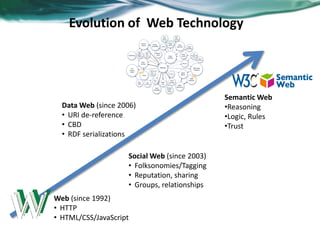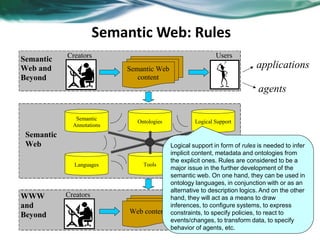Semantic web technology
- 1. Semantic Web Technology STANLEY WANG SOLUTION ARCHITECT, TECH LEAD @SWANG68 http://www.linkedin.com/in/stanley-wang-a2b143b
- 2. What is Semantic Web? • The current Web activities are mostly focus on Machine-to- Human; • Machine-to-Machine activities are not particularly well • supported by software tools. “The Semantic Web is an extension of the current web in which information is given well-defined meaning, better enabling computers and people to work in co-operation.“ [Berners-Lee, 2001]
- 3. Evolution of Web Technology Web (since 1992) • HTTP • HTML/CSS/JavaScript Semantic Web •Reasoning •Logic, Rules •Trust Social Web (since 2003) • Folksonomies/Tagging • Reputation, sharing • Groups, relationships Data Web (since 2006) • URI de-reference • CBD • RDF serializations
- 4. From Web of Document to Web of Linked Data Many Web sites containing unstructured, textual content Few large Web sites are specialized on specific content types Many Web sites containing & semantically syndicating arbitrarily structured content Pictures Video Encyclopedic articles + + Web 1.0 Web 2.0 Web 3.0
- 5. Semantic Web Stack • Machine Processable, Global Web Standards: • Assigning Unambiguous Names (URI) • Expressing data, including metadata (RDF, RDFS) • Modelling Ontologies (OWL) • Query and Retrieve (SPARQL)
- 6. Key Functions of Semantic Web Technology • Ontology Modeling Agreement with a common vocabulary, conceptual models and domain Knowledge; Schema + Knowledge base Agreement is what enables interoperability Formal description - Machine processability is what leads to automation • Semantic Annotation Metadata Extraction: Associating meaning with data, or labeling data so it is more meaningful to the system and people. Can be manual, semi-automatic (automatic with human verification), automatic • Reasoning Computation semantics enabled search, integration, answering complex queries, connections and analyses (paths, sub graphs), pattern finding, mining, hypothesis validation, discovery, visualization
- 7. 7 Semantic Technology Market Forecasting Semantic solution, services & software markets will grow rapidly, topping $60B by 2020
- 8. Semantic Web: Annotations Semantic Annotations Ontologies Logical Support Languages Tools Applications / Services Web content UsersCreatorsWWW and Beyond Semantic Web Semantic Web content Users Semantic Web and Beyond Creators applications agents Semantic annotations are specific sort of metadata, which provides information about particular domain objects, values of their properties and relationships, in a machine-processable, formal and standardized way.
- 9. Semantic Web: Ontologies Semantic Annotations Ontologies Logical Support Languages Tools Applications / Services Web content UsersCreatorsWWW and Beyond Semantic Web Semantic Web content Users Semantic Web and Beyond Creators applications agents Ontologies make metadata interoperable and ready for efficient sharing and reuse. It provides shared and common understanding of a domain, that can be used both by people and machines. Ontologies are used as a form of agreement-based knowledge representation about the world or some part of it and generally describe: domain individuals, classes, attributes, relations and events.
- 10. Semantic Web: Rules Semantic Annotations Ontologies Logical Support Languages Tools Applications / Services Web content UsersCreatorsWWW and Beyond Semantic Web Semantic Web content Users Semantic Web and Beyond Creators applications agents Logical support in form of rules is needed to infer implicit content, metadata and ontologies from the explicit ones. Rules are considered to be a major issue in the further development of the semantic web. On one hand, they can be used in ontology languages, in conjunction with or as an alternative to description logics. And on the other hand, they will act as a means to draw inferences, to configure systems, to express constraints, to specify policies, to react to events/changes, to transform data, to specify behavior of agents, etc.
- 11. Semantic Web: Languages Semantic Annotations Ontologies Logical Support Languages Tools Applications / Services Web content UsersCreatorsWWW and Beyond Semantic Web Semantic Web content Users Semantic Web and Beyond Creators applications agents Languages are needed for machine-processable formal descriptions of: metadata (annotations) like e.g. RDF; ontologies like e.g. OWL.; rules like e.g. RuleML. The challenge is to provide a framework for specifying the syntax (e.g. XML) and semantics of all of these languages in a uniform and coherent way. The strategy is to translate the various languages into a common 'base' language (e.g. CL or Lbase) providing them with a single coherent model theory.
- 12. Semantic Web: Tools Semantic Annotations Ontologies Logical Support Languages Tools Applications / Services Web content UsersCreatorsWWW and Beyond Semantic Web Semantic Web content Users Semantic Web and Beyond Creators applications agents User-friendly tools are needed for metadata manual creation (annotating content) or automated generation, for ontology engineering and validation, for knowledge acquisition (rules), for languages parsing and processing, etc.
- 13. Semantic Web: Applications and Services Semantic Annotations Ontologies Logical Support Languages Tools Applications / Services Web content UsersCreatorsWWW and Beyond Semantic Web Semantic Web content Users Semantic Web and Beyond Creators applications agents Utilization of Semantic Web metadata, ontologies, rules, languages and tools enables to provide scalable Web applications and Web services for consumers and enterprises" making the web 'smarter' for people and machines.
- 14. The Idea of Web Linked Data • Think of the semantic web as building on the ideas behind Linked Data; • Linked Data is nor a specification, but a set of best practices for providing a data infrastructure that makes it easier to share data across the web; • Use semantic web technologies such as RDFS, OWL, and SPARQL to build applications around that data; Four Principles of Linked Data: 1. Use URIs as names for things; 2. Use HTTP URIs so that people can look up those names; 3. When looking up a URI, provide useful information with the standards such as RDF, RFFS, OWL, SPARQL; 4. Include links to other URIs to discover more information;
- 15. Foundation for Future Enterprise Systems • Semantic technology as a software technology allows the meaning of information to be known and processed at execution time. For a semantic technology there must be a knowledge model of some part of the world that is used by one or more applications at execution time. Semantic Technologies represent meanings separately from data, content, or program code, using the open standards for the semantic web such as RDF and OWL W3C standards.
- 16. 16 Drivers for the Semantic Web Technology • Business models develop rapidly these days, so infrastructure that supports change is needed; • Organizations are increasingly forming and disbanding collaborations; • Data is growing so quickly that it is no longer possible for individuals to identify patterns in their heads; • Increasing recognition of the benefits of collective intelligence; It is, essentially, the Web of Data. “Semantic Web Technologies” is a collection of standard technologies to realize a Web of Data
- 17. Semantics Web Technology in Nut Shell • “Semantics” provides a universal framework to describe and link different data so that it can be better understood and searched holistically, allowing both people and computers to see and discover relationships in the data;


![What is Semantic Web?
• The current Web activities are
mostly focus on Machine-to-
Human;
• Machine-to-Machine activities
are not particularly well
• supported by software tools.
“The Semantic Web is an extension of the current web in which
information is given well-defined meaning, better enabling
computers and people to
work in co-operation.“ [Berners-Lee, 2001]](https://image.slidesharecdn.com/semanticwebtechnology-160127192924/85/Semantic-web-technology-2-320.jpg)














